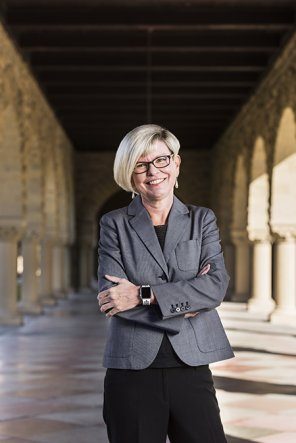
Stanford creates innovation lab to advance women in the workplace with $15 million gift
A generous donation from VMware supports research and greater collaboration between Stanford researchers and business leaders as the answer to long-term, sustainable progress.
Stanford University has launched the VMware Women's Leadership Innovation Lab, an ambitious research and collaboration initiative that seeks to permanently close the gender divide in the workplace. The lab is made possible by a $15 million gift from a donor-advised fund of VMware, the Palo Alto-based information technology giant that has long embraced open discussions and policies aimed at ensuring women are treated equally on the job.
"This initiative enables Stanford researchers and students to better understand why women's advancement in the workplace has been interrupted and to design solutions that, working closely with companies and other organizations, will bring about meaningful change," said Persis Drell, provost of Stanford.
VMware has supported other university programs to level the playing field for women, such as the Seeds of Change initiative, which partners Stanford undergraduates in technology disciplines with female high school students interested in STEM careers; the goal is to expand the year-old program nationally.
"To solve the systemic issue of gender equality, we must actively pursue research and identify solutions that address gender equality as a social good and business imperative," says Pat Gelsinger, CEO of VMware and a Stanford alumnus. "This collaboration between VMware and Stanford bridges industry with academia in order to apply learnings from the research in a real-world environment and change the trajectory of the number of women in leadership positions."
A 'cycle of continuous improvement'
Stanford sociology professor Shelley Correll will be the director of the VMware Women's Leadership Innovation Lab. According to Correll, there is both an urgent need for the kind of long-term, evidence-based studies that the new lab will undertake and for the insights they yield to turn into concrete action. “We are calling this new endeavor a ‘lab’ to underscore our goal of creating broad research collaborations that break down barriers across organizational contexts," she said. "It's critical that we close the gap between what is known in academia and what organizations have been doing in practice."
As one example of the value of joint research to help shape workplace policies, Correll and colleagues have worked with companies to design interventions to block the effects of implicit biases on women’s careers. “We know that simply training managers about bias is not enough, and it can even backfire,” said Correll. "In our research, we have found that if we involve managers in the design of tools and processes to block biases we see immediate improvements. Further, as managers see progress being made, those 'small wins' inspire them to make even more improvements. It becomes a cycle of continuous improvement."
"Too often," added Correll, "organizations will implement a solution, check the box, and think 'one and done.'" "But history has shown that short-term fixes don't work." For example, Correll commended Starbucks for closing 8,000 stores on May 29 for bias training in response to possible racial profiling at one of its locations but noted that lasting improvement will happen only if Starbucks commits to systematically measuring results and fostering continuous improvement.
There's another critical element to closing the gender gap for good. As Betsy Sutter, Chief People Officer of VMware, notes, “gender equality in the workplace will happen only when institutions recognize the need to work together—and not in isolation. This means, for example, identifying what works and then openly sharing their successes with other organizations.”
Correll agrees. “Gender equality, like clean air, is a social good that benefits us all,” she said.
Allies of advancement
The lab builds on work begun five years ago with seed funding from John Hennessy, president emeritus of Stanford, who championed further research and programs aimed at advancing women during his tenure. Nearly 50 companies have since collaborated with Stanford scholars to develop research-based programs designed to first educate managers and employees about bias and then diagnose when and where bias influences evaluations of their employees and develop measurable tools for reducing inequality.
For example, SLAC National Accelerator Laboratory, the Stanford-operated lab of the U.S. Department of Energy, collaborated with Correll and her team to design a process that has resulted in marked improvements in the annual hiring percentage of female scientists.
For Hennessy, currently the Shriram Family Director of the Knight-Hennessy Scholars program, the new lab represents more than a triumph of one of his top priorities during 16 years at Stanford's helm. Thirty years ago, as a professor of electrical engineering, Hennessy taught Gelsinger, who was then pursuing his MSEE, and later served as his faculty mentor. The two have had long discussions over the years about the essential role of women in innovation and as leaders in solving social problems.
"By partnering with Stanford through this gift and other critical initiatives, Pat and VMware are supporting work that will result in sustainable change for women in the workplace," said Hennessy, who stepped down as president in 2016.




